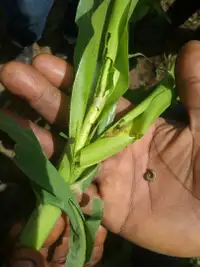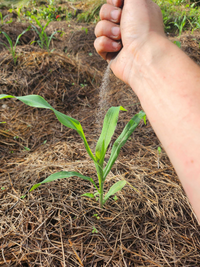Introduction
Tell us a bit about yourself, your background, and your experience.
I am a crop entomologist. I received my PhD in entomology from North Carolina State University and have over 30 years of experience living in six countries and working in over 50 countries. I have worked for national universities in Nicaragua and Honduras, NGOs (including CARE), the Food and Agriculture Organization of the United Nations, and Michigan State University. My technical work has focused on how to improve the sustainable production and livelihoods of smallholder farmers and families. When the fall armyworm (FAW; Spodoptera frugiperda) invaded Africa and Asia, I was chosen to lead FAO’s Global Program on FAW. I led a team at the FAO Head Quarters and national teams to develop a comprehensive, inclusive program targeting smallholder farmers and the national programs and policies that support them.
FAW management options
Are there practical, low-resource ways for smallholder farmers to control FAW and if so, what are they?
Yes!
The most important first step is to help smallholders and the local extension service and Ministry of Agriculture understand that FAW is manageable and the damage is often local and not crop-threatening. The ‘panic’ paradigm and response leads to many bad decisions, including the rush to give away or use pesticides that are often older molecules that are still used in Africa because they are cheap. One example of this problematic response was what happened in one country where the Ministry of Agriculture procured (with donor support) and gave away to farmers carbosulfan, a product that was de-authorized in Europe due to it being a human carcinogen.

Figure 6. FAW caterpillar removed from base of a maize whorl and typical damage. Source: ECHO East Africa Staff
One of the very effective, low-resource, and accessible techniques that we have seen smallholders readily adopt is the use of applying soil directly to the whorl of damaged maize (Zea mays) plants. FAW causes very distinctive damage to young maize leaves, as FAW larvae prefer to be in the base of the whorl (Figure 6) so that they can eat young leaves as they emerge from the growing point of the plant. Farmers can quickly learn to identify the damage and find that applying a small amount of soil (the amount that is pinched between the thumb and forefingers) is often very effective in immobilizing or killing the larvae. This practice is common among smallholders in Central America and Mexico who have been managing FAW in their maize fields for millennia.
Are there any effective preventive measures against FAW? How effective are fungi like Beauveria bassiana and Metarhizium anisopliae? Parasitic wasps?
The most effective proactive measures that smallholder farmers can take in their maize fields are to increase plant diversity and not spray broad-spectrum pesticides. Plant diversity has been shown to decrease oviposition in maize fields by FAW. Planting beans in maize fields has been shown to decrease oviposition by 30%. This is due to the volatile chemicals that beans emit, making the fields less attractive to female FAW adults. Natural enemies (parasitoids, predators, and pathogens) can be highly effective in the natural mortality of FAW when the populations of the natural enemies are allowed to build to effective levels. Plant diversity helps promote higher populations of predators and parasitoids, in part because they harbor alternative food sources. Pathogens are among the most effective and least understood natural enemies of FAW in maize fields. There are several well-known fungi (including Beauveria and Metarhizium), bacteria (including Bacillus thuringiensis), and viruses (Nuclear polyhidrosis virus of FAW). They are all naturally occurring and their populations build as they infect FAW and the spores, cells, and viroid particle populations build. These then drop to the soil, where they reside and are viable for months. The presence and effectiveness of these pathogens are some of the reasons that soil works as a control measure. Ultraviolet sunlight kills certain pathogens, notably the virus. This is one reason that the effectiveness of commercial formulations of viroid particles is limited.
Is there government support for FAW control in many countries?
Government support is variable among countries. Some are doing an excellent job of working with researchers and farmers to better understand infestation levels, maize yield loss, and practices that are effective and accessible by smallholder farmers. Other countries have been stuck in a ‘panic’ mode, providing chemical insecticides, often funded by international donors.
Early detection of FAW
Are there ways to know if there will likely be a FAW outbreak in your region?
Many conditions combine to result in high FAW levels in a region, including local cropping patterns, rainfall, and any large-scale migration. The monitoring of FAW populations and correlation to these factors is a good job for local extension agents and the Ministry of Agriculture. Heavy rains at small plant stages can kill a large percentage of larvae in the maize whorls.
What are the field conditions that indicate FAWs may be fast approaching?
Adult FAWs are strong fliers and can come in from neighboring fields or from areas that were previously heavily infested. FAW prefers maize over any other plant and populations increase rapidly as maize plantings begin at the onset of rainy seasons. Late planted maize can attract large populations of FAW adults, as they move from earlier planted maize fields.
How important is monitoring FAW and when should a farmer intervene?
The most important monitoring that smallholder farmers can do is work through their fields and look for the characteristic damage of young leaves. In most cases, FAW infestation is patchy in a field. Young larvae do not travel far, preferring to burrow into the nearest whorl. Farmers can quickly identify the patches of infested maize. If they walk their fields once a week and apply soil to infested plants, they should be able to manage FAW in their maize crop. Management can be very resource-effective by often walking through fields and applying soil only to plants that show damage. They should do this from about a week after plant emergence until the tassel begins to emerge.
Research
What is the most up-to-date research about the impact of FAW at the smallholder level?
The most up-to-date research from several detailed studies quantifying the relationship between FAW infestation and yield reduction in maize shows that the yield loss is not nearly as great as often portrayed. Early estimates of yield loss in Africa were based on farmers’ surveys, which have proven to be overestimated. Since then, detailed field studies have shown that even at higher levels of FAW infestation, the yield loss due to FAW is in the 10-20% range. While still significant, especially to smallholder families, these estimates are considerably lower than the “total destruction” or “devastation” rhetoric that is still often used. This is important, as a dramatic narrative promotes fast, unconsidered actions. This “panic” narrative has been used to justify the use and give-away of highly dangerous pesticides.
Does FAW significantly affect crops other than corn?
Maize is the preferred crop of FAW. When available and abundant, maize fields and plants will attract most female moths and maize fields are the most affected. In the absence, or scarcity of maize plants, female FAW will oviposit on other plants and crops, starting with other grass family plants. This is why FAW is reported in rice (Oryza sativa), millet (Pennisetum glaucum), and sorghum (Sorghum bicolor). In the absence of grass species, FAW will oviposit and larvae can feed on a wide range of crop plants, including peanut (Arachis hypogaea), eggplant (Solanum melongena), cotton (Gossypium spp.), etc. These are usually sporadic infestations, although in certain areas with particular cropping patterns, they can be severe and repeated.
What is the most up-to-date research about effective control of FAW at the smallholder level? How effective are low-resource control options like grains of urea or soil in the whorl? Does it need to be a specific type of soil to be effective?

Figure 7. Adding soil (sandy in this case) to the wholr of a maize plant. Source: Abby Bowen
One of the most effective, accessible, and safe FAW management tactics is the use of soil, as described above. Smallholder farmers in Mesoamerica have long used this practice, applying a pinch of field soil to infected plant whorls (Figure 7). The rapid adoption of this tactic by farmers in Africa has led to an interest in studying this practice. This research is looking at the mechanisms of mortality, which will lead to specific recommendations. Until this research is done, farmers will continue to try different types of soils, their humidity content, and timing of applications to find what works best for them.
Can artisanal production of biological agents be improved? What is the most practical?
I have seen artisanal production of parasitoids successfully carried out in Cuba, where the government provided artisanal mass production of biological control agents for local farms, especially focusing on fungi and egg parasitoids. Brazil has successful small businesses that sell farmers egg parasitoids. I have seen sugar plantations that produce entomopathogenic fungi [fungi that kill insects] for their own use. What’s needed is a clear, sustainable business model for local producers.
Is there documented resistance to Bt in GMO maize?
There are numerous cases of field-evolved resistance to transgenic Bt-maize. Some of the early varieties of single-gene transgenic Bt resistance lasted only a few years. This has been documented in the literature from fields in the US, Brazil, and South Africa.
Does crop modeling (weather conditions) or field scouting more accurately predict outbreaks?
FAW has short-range and long-range (migration) movement. In the United States, FAW migrates north every year because it does not overwinter in areas that have sub-freezing temperatures. The northward migration used to be of great interest to US farmers, as it was useful to prepare farmers for its arrival and possible control. In tropical and sub-tropical areas (virtually all of Africa and much of Asia), this is not the case and FAW is locally present year-round. In these areas, FAW movement is much more local and dependent on rainfall, planting patterns, and the availability of alternative plant foods. In these locations, modeling is very dependent on the measurement of local conditions. The density of monitoring is often not great enough in rural areas of Africa and South Asia to make models useful. In these localities, local attention to rainfall, maize planting, and field observations is much more useful. Farmers can participate directly and the most precise information can be gained by walking through their fields and noting the presence of FAW damage in their maize fields.
Recommended publications by Allan Hruska:
Fall armyworm (Spodoptera frugiperda) management by smallholders [http://edn.link/e9hmr7]
How to manage fall armyworm: A quick guide for smallholders [http://edn.link/j4t7pa]